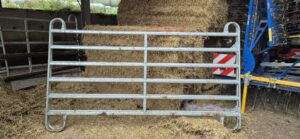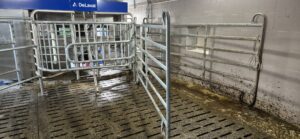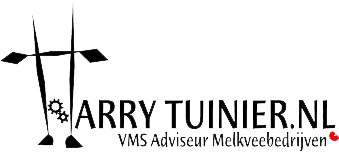November 2013:
Tips before Startup with VMS
Recently a lot of new stalls have been built. It is good to see that many farmers have chosen for automatic milking.
At DeLaval you almost always get an “Integration book” or handout. The handout contains different tips for both the farmers as well as the technicians. Some useful tips for the farmer are:
- Start up with a maximum of 50-55 cows per VMS. Cows as well as the farmer himself must learn something new, starting with the robot full makes it much heavier. When the cows have all calved at least once, you may expand that number carefully.
Because of higher capacity on VMS V300 it could be 5 – 10 cows more. - Plan the milking robot(s) in a place where the cows now also like to stay.
- In the last period you are milking in the milking parlour, pre-treat per cow and then connect, so do not pre-treat 3 – 5 cows and then connect one after the other.
- Milk the last morning as early as possible, and when half the cows have been milked, preferably lock them up near the robot so that we can start with these cows, and then milk the second half of the cows and lock them up elsewhere.
- It is important that when you change the ration, for example from full TMR, that in the weeks beforehand are slowly being phased out and the cows learn to eat and appreciate food from concentrate.
- Structural feed is very important for the health and especially activity of the cow.
So with sufficient structure in ration, the cow learns faster!
But also around the start-up, eating and drinking is sometimes disrupted or the cow also eats concentrate from the previous cow because she was frightened.
Then a little extra structure around startup can accommodate this. - All of the cows need to be hoof trimmed a month in advance. If you have a new stall or new concrete then it is recommended to trim 3 months in advance. Otherwise the trimmed hoofs are too thin and that causes problems.
- Even though we say that with DeLaval VMS can milk “every cow”, we still advise to prematurely say farewell to the cows that have no chance. These cows include the structural SCC, cows with bad legs that you have to walk and chase after now already. Also cows that have the rear teats in the ligaments are also difficult. As for the rest, you know your cows the best.
- Shave utter and tails a few days before starting.
- Place a few oneway gates in the old situation, old stable or in the young cattle shed, as they will be in the new situation.
Then they can get used to it. - Make sure that when the start-up day comes you have no other attention seeking problems. The mechanic and the (in Holland and Germany) special Start-up team have enough to explain. It would be a pity if you don’t remember any of it.
This makes as well the cows as Farmer less stressful and then goes the day a lot easier and learns the farmer also more.This al has to make that the farmers enjoyed the start-up day!
- Provide an adequate amount of gates which bring a lot of peacefulness (if setup right)
 during the startup. Feedfirst needs a few gates less, color markers can be useful here.
during the startup. Feedfirst needs a few gates less, color markers can be useful here. - Ask a few extra people to help ensure that the cows are milked often enough per day for ≈ the first two weeks after start-up until they understand it themselves.
June 2011:
Efficient layout barn plan.
Do you have renovation or new building plans?
Consider the following list:
I have in 3 minutes, or one person can (!):
- A newly calved cow brought into the VMS
- A lame cow in the treatment box
- Separate a cow to treat
- A dry cow moved to other group
- A calf moved to new group
- The young cattle moved to new groups
In my (new) walking route, I see three times a day:
- The milking cows
- The dry cows
- Newly calved cows
- Heifers
- Calves
- The sensors of the feed auger
My cows have to make as less short turns in barn and around VMS as possible to save their claws.
(Also -especially- the dry cows?)
And if you have no other possibility it is to consider to put rubber on these places on the racks!
And maybe you have for yourself even more ideas, good luck!
June 2018:
Cow Whisperer.
In many places I am called the Cow Whisperer.
Although it is an honor in itself, it’s also nonsense of course. What is true though, is that I can usually get the cow to go where I want her to go.
I am not familiar with using a stick or screaming.
What does help is: Try to think like the cow. Because the cow in the new situation has to get out of her comfort zone to go somewhere she doesn’t actually want to go. Like the first time she has to go to a milking robot. This also goes for moving to a new stall, new group, straw/ calving box, claw care box, etc.
This is why the cow looks around for possibilities to escape back to her safe environment.
This is also deeply rooted in her instinct.
Hitting a cow (hand or stick or shocks) causes the cow to think about where it was hit (on her back or ass), instead of paying attention to where she needs to go.
Instead of finding out where she can go, she flees to where she needs to go.
That doesn’t bring back the best memories ..
Fences, preferably ones that move, make very clear to understand for the cow: It is impossible to go to the left and also impossible to the right!
By standing behind the cow and holding her tail firmly, she’ll know she can’t go back either.
Then I usually wait until the cow does see where she can, and has to, go. At that moment this is followed by a friendly but urgent push which is often sufficient. Working like this looks like it takes a bit more time, but it takes away a lot of stress from the cow and from you, the farmer.
And after all doesn’t take more time (or power) at all.
The cow also will have better memories of her first visit and you’ll understand what that’s worth! The farmer will observe his/her cows experiencing the new situation in a peaceful manner which is healthier for the cow, but also for the farmer!
So also here: “If the cow could make her own choice, (between stick or fences) she knew what to do!”
March 2023:
Three steps up and three steps down.
Do you have construction or renovation plans?
Nowadays, when the robot place is constructed, a pit is often made near the robot. This is very useful when you want to do something with the cow and the udder.
Obviously no treatments that cause painful and bad memories for the cow of the robot visit.
Then three steps down is a nice size to be able to reach everything.
For the office space, three steps up is very pleasant.
When the office is in a good place, you have a beautiful view over the cows and “the stable!”(Being able to look over the robot into the stable is often an extra three steps higher).






